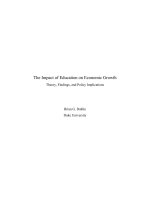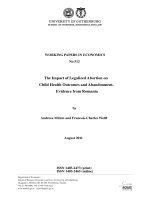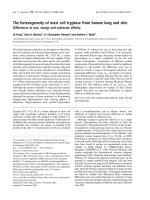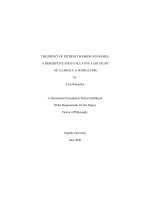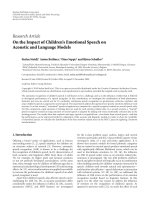The impact of tax amnesty announcement towards share performance and market reaction in Indonesi
Bạn đang xem bản rút gọn của tài liệu. Xem và tải ngay bản đầy đủ của tài liệu tại đây (254.3 KB, 9 trang )
Accounting and Finance Research
Vol. 7, No. 2; 2018
The Impact of Tax Amnesty Announcement towards Share Performance
and Market Reaction in Indonesia
Lidya Agustina1, Yuliana Gunawan1 & Windawaty Chandra2
1
Permanent Lecturer at Faculty of Economics Accounting Program of Maranatha Christian University, Jl. Prof.
Drg. Surya Sumantri No.65 Bandung 40164, Indonesia
2
Student at Faculty of Economics Accounting Program of Maranatha Christian University.
Correspondence: Lidya Agustina, Faculty of Economics Accounting Program of Maranatha Christian University, Jl.
Prof. Drg. Surya Sumantri No.65 Bandung 40164, Indonesia
Received: November 2, 2017
Accepted: January 16, 2018
Online Published: January 16, 2018
doi:10.5430/afr.v7n2p39
URL: />
Abstract
The Indonesian Government reviewed back the tax amnesty in 2016. Various reactions came up along with the
announcement of tax amnesty, the investors did not accept- which led to the announcement of the Tax Forgiveness
regulation through the market reactions and stock market performances in Indonesia Stock Exchange. This research
is to analyze event study using information based on government-related announcements to show the impact of the
new regulation towards stock performance and market reaction. The effect of the announcement will be seen from
the changes in stock-prices or stock-returns that provide abnormal returns in the event period as well as market
reaction which reflected in trading volume. This research used stock-return data and trading volume from all
companies listed in IDX in 2016 and analyzed using the Paired Sample T-Test method. The result of this research
shows there are differences among the average of stock-return, average abnormal-return of stock, and stock trading
volume before and after the tax amnesty announcement.
Keywords: Event study, Tax amnesty announcement, Stock performance, Market reaction
1. Background of Research
Capital market is a broad category of markets facilitating the buying and selling of financial instruments. It plays a
big role for a country’s economy it moves money from people who have it to organizations who need it in order to be
productive. Investing is about putting money into stocks, bonds, mutual funds, or capital investment for one asset or
more, which is usually for long-term, with the expectation of obtaining an additional income or profit. The
development of the investment trend in Indonesia is reflected through the increase in stock-trading transactions that
occurred in Indonesia Stock Exchange (IDX a.k.a BEI). It shows a positive impact of the economic improvement of
Indonesia.
According to Malinda (2011:5), there are several factors that affect the success rate of capital market: (1) Supply of
securities; (2) Demand of securities; (3) The political and economic conditions of a country; (4) Legal and regulatory
issues; (5) The existence of institutions that organize and supervise transactions efficiently. Of all these factors, the
most common phenomena in Indonesia are the political and economic conditions such as an establishment of a
policy or law. This condition is one of the factors that can cause the capital market to react.
The Government of Indonesia once again reviewed the tax forgiveness law, or better known as tax amnesty.
There were some reasons for Indonesian Government to issue Tax Amnesty Policy: many tax payers had not reported
their Capital Assets (either domestic or overseas) to their Annual Income Tax, to increase the national revenue as well
as the economic growth, to trace the assets of Indonesian investors who invested their fund on illegal companies to
avoid the tax as stated in Panama Papers case. Base on these reasons then On July 1 2016, the Indonesian government
announced the Act No.11 year 2016 about Tax Amnesty, which aims to fundamentally and thoroughly improve the
macro-economic conditions in Indonesia. Tax amnesty provides an opportunity for tax payers, both individuals and
entities, which have not yet fulfilled the tax obligation on their possessions to disclose their property, both
domestically and abroad and to pay ransom money instead of the penalty. Tax payers who participate in tax amnesty
will be freed from tax-administration and criminal penalties in the field of taxation.
Published by Sciedu Press
39
ISSN 1927-5986
E-ISSN 1927-5994
Accounting and Finance Research
Vol. 7, No. 2; 2018
The purpose of tax amnesty among others: to accelerate and revamp economic growth by legal-assets-transfer which
would impact to the increasing domestic liquidity and Indonesia’s currency and decreasing rate of interest, and to
encourage tax reform and to enlarge a more comprehensive, integrated and valid tax database.
Tax Amnesty has brought positive influence to the domestic stock market. The capital market surged as the guarantee
for the massive fund flow caused by this new policy. Thus, foreign investors would also invest their fund in Indonesia,
mainly though the stock market..
Various reactions emerged against the announcement of tax amnesty, not to mention the reactions of investors who
responded to the announcement of tax amnesty through market reaction and stock market performance in Indonesia
Stock Exchange. But in fact, when the Tax Amnesty Act was carried out on July 1, 2016, ICI (a.k.a. Indonesia Coal
Index) was closed down by decrement of 45.07 points to 4,971.58 from the previous closing points of 5,016.65.
Likewise, it was recorded that the stock trading volume was decreased to 3.9 billion compared to the previous
closing day which was 5.3 billion (www.idx.go.id).
The Changes in stock prices and stock trading volume in the stock exchange have become an important indicator for
investors on transactions’ decisions making in stock market. This happens because the investors tend to make
transactions’ decisions based on the information they get so the haveges in stock prices and trading volume are
reflections of the information that investors believe. This research aims to analyze based on event study.
“Event study” is a study of market reaction towards an event which information is published as an announcement
(Jogianto, 2010). The analysis of event study can be used to analyze the semi-strong form of the market efficiency.
Jogianto (2010) explained that the market is said to be semi-strong efficient if the prices of securities have fully
reflected the published information. The information mentioned may be such as earnings-related announcements,
forecasting announcement by company’s officials, dividend announcements, fund announcements,
government-related announcements, investment announcements, employment announcements, law-related
announcements, marketing-production-sales announcements, management-directors announcements, announcements
of merger-take over-divestment, securities industry announcements, and etcetera.
Based on the information above, this research aims to analyze the event study by using the information based on
government-related announcements to see the effect of the new regulations towards stock performance and market
reaction. The existence of the effect from the announcement will be seen from the changes in stock prices or stock
returns (stock performance) that provides an abnormal return in the event period.
Stock performance is an achievement measurement that can be accomplished by the company's stock management
and reflects the company's health condition (Sudarsini, 2005). Therefore, stock return that shows the value of stock
price changes in the market, and abnormal return that shows that the return is not normal, both of them is because of
an event or announcement which is able to show the performance of stock. While the existence of an announcement
related to the government's policy may lead to a surge in the number of outstanding shares in the community. This
shows that an announcement may affect the market reaction, the more positive signal given from the announcement
for the investors, the frequency of the transaction will also increase as the investors interest to the stock is also in
high demand.
The previous research on event study that occurred in the public company's environment such as announcement of
merger policy, right issue announcement, stock split, buy back, dividend payout, insider trading, and earnings
announcement have often been done. However, research that analyzes the event study that occurs due to various
regulations and economic deregulation issued by the government in Indonesia has not been much analyzed.
Previous researches that examined on event study related to economic events in Indonesia include the liquidation of
16 banks events in 1997, the announcement of the increase of fuel prices on April 1 2002, and the announcement of
the approval of the Governor of Bank Indonesia on May 14 2003 (Manullang 2004). The results of previous
researches showed a significant negative abnormal returns before and after the announcement of the delay of
disbursement of IMF funds (Mahgianti, 2001), there are significant abnormal returns on 31 events (28 social political
events and 23 economic events between 1996-2003), and IDX was in a semi strong efficient market condition
(Manullang, 2004), then Zaqi (2006) proved that there is a market reaction towards the economic and social-political
events that occurred in Indonesia. Therefore, based on the background that has been explained above, this research
aims to analyze whether there are differences in stock returns, stock return abnormalities and stock trading volume of
all companies that are listed at Indonesia Stock Exchange (ISE) in 2016 before and after the date-announcement of
Tax Amnesty. The results of this research are expected to provide a new point of view or input for the investors in
analyzing an announcement in decision-making for transactions in the stock market.
Published by Sciedu Press
40
ISSN 1927-5986
E-ISSN 1927-5994
Accounting and Finance Research
Vol. 7, No. 2; 2018
2. Hypothesis Development
2.1 Market Efficiency
An efficient market concept is emphasized on the information aspect, which means that an efficient market is a
market where the prices of all traded securities have reflected to all the available information, both past and present
information, as well as information of opinion or rational opinion circulating in a market that may affect the stock
price changes in the market (Tandelilin, 2010). The concept of market efficiency shows a process of adjusting stock
prices so a new equilibrium is achieved as a form of market response to the existed information
Efficient market hypothesis emphasizes how fast new information is absorbed by the market as reflected in
adjustments to the new equilibrium price (Tandelilin, 2010). Analyzing of event study can be used to analyze the
semi strong form of the market efficiency (Jogianto, 2010).
Event study is a study which studies about market reaction towards an event which the information is published as an
announcement (Jogianto, 2010). Event study is used to analyze the information content of an announcement, where
good news will get a positive response by the market as reflected through market prices that will provide positive
abnormal returns implications. As for bad news will give a bad market response which is reflected through market
prices that will provide negative abnormal returns implications.
Hartono (2007) forecasted stock performance using stock return and daily abnormal stock return around the
announcement date. Meanwhile, according to Ika and Purwaningsih (2008) market reaction can be shown by changes
in stock prices, frequency of stock trading, and stock returns on the market. Therefore, events which have occurred
that contain relevant information content to investors will cause a market reaction which is reflected through changes
in stock prices. The results of previous research showed that there were differences between stock returns and
abnormal returns before and after the occurrence of announcements or events (Mahgianti, 2001; Manullang, 2004;
Zaqi, 2006; Sari, 2015). Based on the description above, the hypothesis can be formulated as follows:
H1 = there is a difference of the average of stock return in IDX in 2016 before and after tax amnesty
announcement
H2 = there is a difference of average abnormal return of company stock in IDX in 2016 before and after tax
amnesty announcement
Market reaction can be reflected from the high interest of investors towards a stock, so if the stock is in a great
demand, investors will try to get the stock as much as possible. Therefore, market reaction can be reflected from the
level of stock trading volume. Changes in stock prices and stock trading volume on the stock exchange have become
an important indicator for investors on transactions decisions making in the stock market. This happens because
investors tend to make transactions based on the information they have. While the existence of an announcement that
can cause a surge in the number of the outstanding shares in the community. This shows that an announcement may
affect the market reaction, the more the positive signal is given from the announcement for the investors, and the
frequency of the transaction will also increase as the interest of the investors towards stock is also high.
The results of previous research that analyzed the event study on political events in Indonesia towards market
reaction which is represented by trading volume showed that the stock trading volume which contained significant
differences in the period before and after political events were shown in Meidawati and Harimawan (2004) ,
Wardhani (2013), and Sari (2015) research. Based on the description above, the hypothesis can be formulated as
follows:
H3 = there is a difference of average stock trading volume in IDX in 2016 before and after tax amnesty
announcement
3. Research Methods
This research is an event study that aims to observe the response towards an event. The data used in this research are
stock price data and stock trading volume for all sectors of companies that are listed at Indonesia Stock Exchange in
2016 which were downloaded at www.idx.co.id with the following criteria:
a.
Companies which are listed at IDX in 2016;
b.
Companies which have issued the audited financial report of 2015.
Published by Sciedu Press
41
ISSN 1927-5986
E-ISSN 1927-5994
Accounting and Finance Research
Vol. 7, No. 2; 2018
Table 1. Operational Variable
Variable
The
date
Definition
Note
announcement
The announcement date means the date when the
Indonesian government announced the tax amnesty
policy, which is on July 01, 2016.
Stock returns
A Return is a result of investment.
The stock return could be indicated
from the realization return. The
realization return is a return that has
occurred which is calculated using
historical data. The realization return
is important because it is used as one
of the performance indicators of the
company and as a basis for
determining expected return to
measure the future risk (Jogianto,
2010).
Stock returns or realization return can be calculated
by deducting the closing price day-t with the
closing price of day (t-1), then dividing it with the
closing price of day (t-1).
Abnormal Return
An Abnormal return is an excess of
the actual return toward the normal
return (Jogianto, 2010).
As for the steps used to calculate abnormal return is
as follows (Jogiyanto, 2010):
a. Calculate the expected return that will be
calculated using a market-adjusted model.
IHSGt – IHSGt − 1
E(Ri, t) =
IHSG t − 1
b. Calculate the daily abnormal return of each
stock during the event period by using the following
calculation: ARi, t = Ri, t - E (Ri, t)
c. Calculate the Cumulative abnormal return
(CAR) during the event period using the following
calculation: CARi,t = Σ ARi,t
Trading
Activity
Volume
Stock trading volume is the number
of stocks traded and being
compared with the number of
outstanding shares (Hartono, 2007).
Trading Volume Activity (TVA) is used as a
measurement of stock trading volume to see if
investors will respond positively or negatively
towards an announcement.
i Company stocks which are traded at t time
TVA=
t time
i Company outstanding shares (listing) at
The hypothesis of this research will be analyzed using a different test method from the previous research, which is
Paired Sample T-Test, an analytical tool to analyze if there are any significant differences of the average of stock
return and average abnormal return, and stock trading volume before and after the announcement. The reason of
using Paired Sample T-Test method is because the data which tested are related one to another.
4. Research Result
4.1 Result
Based on the observation of 535 company's stocks in IDX in 2016 for 10 days before and 10 days after the
announcement of Tax Amnesty, the information content around the announcement period can be explained through
table 2 as follows:
Published by Sciedu Press
42
ISSN 1927-5986
E-ISSN 1927-5994
Accounting and Finance Research
Vol. 7, No. 2; 2018
Table 2. Stock returns around the announcement of Tax Amnesty
Test Value = 0
t
df
Sig.
(2-tailed)
Mean Difference
95% Confidence Interval
of the Difference
Lower
Upper
RS_10
2,237
528
,026**
,00275558
,0003358
,0051754
RS_9
3,792
528
,000*
,00520282
,0025075
,0078981
RS_8
2,700
528
,007*
,00382654
,0010428
,0066103
RS_7
1,072
528
,284
,00242966
-,0020207
,0068800
RS_6
-1,696
528
,091
-,00317212
-,0068467
,0005025
RS_5
-5,542
528
,000*
-,00630966
-,0085463
-,0040730
RS_4
1,392
528
,165
,00166189
-,0006843
,0040081
RS_3
2,040
528
,042**
,00244117
,0000906
,0047917
RS_2
2,699
529
,007*
,00573832
,0015621
,0099145
RS_1
2,201
530
,028**
,00589021
,0006330
,0111474
RS0
,149
530
,882
,00023107
-,0028199
,0032821
RA+1
5,770
528
,000*
,00962497
,0063479
,0129021
RA+2
2,369
528
,018**
,00624681
,0010674
,0114263
RA+3
2,425
528
,016**
,00352647
,0006697
,0063832
RA+4
-,370
528
,711
-,00073142
-,0046124
,0031496
RA+5
2,565
528
,011**
,00384905
,0009009
,0067972
RA+6
1,416
528
,157
,03358025
-,0130046
,0801651
RA+7
1,448
528
,148
,05078798
-,0181090
,1196850
RA+8
3,688
528
,000*
,00584017
,0027292
,0089511
RA+9
-,770
528
,442
-,00115856
-,0041145
,0017974
RA+10
-,349
528
,727
-,00043735
-,0028964
,0020216
* Significant at α=1%
Source: SPSS result
**significant at α=5%
Based on table 2, it can be seen that before the date of the announcement of Tax amnesty (RS 0), the decline in stock
return occurs only in the period of -6 and -5which is indicated by a negative value. While in the period of -4 days
before the announcement until the period of +3 days after the announcement, the stock return tends to increase which
is indicated by a positive value, but stock return shows a great increment in the period of +1 after the announcement.
Decrease in stock return again occurred after the announcement period which is in the period of +4, then increased
again and eventually decreased in the period of +9 and +10 again.
Based on the observations, it can be seen from table 1 that the announcement of Tax amnesty gives a positive signal
for investors, it is shown from the stock return on the day of announcement and after announcement has increased.
On the day of the announcement of Tax Amnesty, stock return showed the amount of 0.00023107, while on the day
after the announcement of Tax amnesty, the stock return has increased to 0.00962497. The increase in stock returns
that occurred also shows that there is an occurrence of abnormal return in the period of Tax amnesty announcement.
Table 2 shows observations towards abnormal returns for the periods before and after the date of the announcement.
Table 3 shows that there is a negative abnormal return in the period of -3 and -2 before the announcement, while the
positive abnormal return occurred in the period of -1, while on the announcement date, a negative abnormal return
occurred. Furthermore, the positive abnormal return occurred in the period of +3 after the announcement date, but in
the period of +7, the negative abnormal return occurred again and afterwards in the period of +8 and +9, the
abnormal return was back to positive.
Published by Sciedu Press
43
ISSN 1927-5986
E-ISSN 1927-5994
Accounting and Finance Research
Vol. 7, No. 2; 2018
Table 3. Abnormal returns around the announcement of Tax amnesty
Test Value = 0
t
df
Sig. (2-tailed)
Mean
Difference
95% Confidence Interval of the
Difference
Lower
Upper
AR_9
-,470
526
,638
-,0006478558
-,003353261
,002057550
AR_8
,506
526
,613
,0007201708
-,002074134
,003514475
AR_7
-,563
526
,574
-,0012800569
-,005747340
,003187226
AR_6
,755
526
,451
,0014175901
-,002270988
,005106168
AR_5
1,591
526
,112
,0018180835
-,000426798
,004062965
AR_4
1,134
526
,257
,0013598292
-,000995260
,003714918
AR_3
-5,901
526
,000**
-,0070874953
-,009446903
-,004728087
AR_2
-6,701
527
,000**
-,0142998106
-,018491768
-,010107853
AR_1
5,910
528
,000**
,0092139319
,006151371
,012276493
AR0
-5,979
528
,000**
-,0099744802
-,013251585
-,006697376
AR1
,086
528
,931
,0002269187
-,004952529
,005406367
AR2
-2,215
528
,027*
-,0032206427
-,006077382
-,000363904
AR3
4,599
528
,000**
,0090863894
,005205391
,012967388
AR4
-,927
528
,354
-,0013910397
-,004339216
,001557136
AR5
1,273
528
,204
,0301902647
-,016394626
,076775156
AR6
1,196
528
,232
,0419477127
-,026949288
,110844713
AR7
-4,856
528
,000**
-,0076903025
-,010801262
-,004579343
AR8
2,507
528
,012**
,0037716446
,000815689
,006727600
AR9
2,671
528
,008**
,0033428166
,000883815
,005801818
* Significant at α=1%
Source: SPSS
**Significant at α=5%
4.2 Hypothesis Test
The hypothesis of this research is tested using Paired Sample T-Test to see if there are differences of two data groups,
which are data before the date of the announcement and data after the date of the announcement.
The test result of Paired Sample T-Test on stock return data group before and after the Tax Amnesty announcement
can be seen in table 4 and table 5 as follows:
Table 4. Average of stock returns
Mean
N
Std. Deviation
Std. Error Mean
Pair
RS_BF
,00197104272
534
,011626681559
,000503135718
1
RS_AF
,01100881264
534
,097388683919
,004214420526
Published by Sciedu Press
44
ISSN 1927-5986
E-ISSN 1927-5994
Accounting and Finance Research
Vol. 7, No. 2; 2018
Table 5. Difference in average of stock returns test
Paired Differences
Pair 1
RS_AF
RS_BF –
Mean
Std.
Deviation
Std. Error
Mean
,009037769
919
,09826168
840
,00425219
6547
95%
Confidence
Interval
of
the
Difference
Lower
Upper
t
df
Sig.
(2-tail
ed)
-,01739089
00
,0006846
499
-2,12
5
533
,034
Source: SPSS
Table 4 shows that the average stock price after the announcement of tax amnesty has increased compared to the
average of the previous stock price (0.00197104272 <0.01100881264), while table 5 shows that the difference of the
average of stock price before and after the announcement date is significant (2-tailed) at the 5% level by 0.034. Thus,
the first hypothesis is accepted or in other words there is a difference in average of stock returns before and after the
date of tax amnesty announcement. The results of this research are in common with Mahgianti (2001), Manullang
(2004), Zaqi (2006), Sari (2015), who found differences in stock returns and abnormal returns before and after the
announcement or an event.
The test result of Paired Sample T-Test towards abnormal return data group before and after the date of tax amnesty
announcement can be seen in table 6 and table 7 as follows:
Table 6. Average Abnormal returns
Mean
N
Std. Deviation
Std. Error Mean
Pair
AR_BF
-,00081616481
532
,011646600980
,000504944191
1
AR_AF
,00663434060
532
,097561329387
,004229820068
Table 7. Difference in Average abnormal returns test
Paired Differences
Pair 1
AR_BF –
AR_AF
Mean
Std.
Deviation
Std. Error
Mean
,007450505
414
,09843977
3174
,00426790
5436
95% Confidence Interval
of the Difference
Lower
Upper
t
df
Sig.
(2-tail
ed)
-,01583455
63
,00093354
5424
-1,7
46
53
1
,081
Source: SPSS
Table 6 shows that the average abnormal returns after the date of tax amnesty announcement has increased compared
to the average abnormal return before the announcement date (0.00081616481 <0.0066343406), while in table 7
shows that the occurrence of differences in average abnormal returns before and after the announcement date is
significant (2-tailed) at the 10% level by 0.081. Thus, the second hypothesis is accepted or in other words there is a
difference in average abnormal return before and after the date of the announcement of Tax amnesty. The results of
this research are in common with Mahgianti (2001), Manullang (2004), Zaqi (2006), Sari (2015), who found
differences in stock returns and abnormal returns before and after the announcement or an event.
The test result of Paired Sample T-Test towards abnormal returns data group before and after the date of tax amnesty
announcement can be seen in table 8 and table 9 as follows:
Tabel 8. Average of Trading Volume
Mean
N
Std. Deviation
Std. Error Mean
Pair
VOL_BF
,00001820368
532
,000047814649
,000002073028
1
VOL_AF
,00002423440
532
,000067768697
,000002938146
Published by Sciedu Press
45
ISSN 1927-5986
E-ISSN 1927-5994
Accounting and Finance Research
Vol. 7, No. 2; 2018
Table 9. Difference average of trading volume test
Paired Differences
Pair 1
VOL_BF –
VOL_AF
Mean
Std.
Deviation
Std. Error
Mean
,00000603
07
,00047599
926
,00002063
72
95% Confidence Interval
of the Difference
Lower
Upper
t
df
Sig.
(2-ta
iled)
,00001008
4769
,00000197
67
-2,9
22
531
,004
Source: SPSS
Table 8 shows that the average of stock trading volume after the date of the announcement of tax amnesty has
increased compared to the average of stock trading volume before the announcement date (0.00001820368
<0.0000242344), while in table 9, it is shown that the occurrence of difference in average of stock trading volume
before and after the announcement date is significant (2-tailed) at the 5% level by 0.004. Thus, the third hypothesis is
accepted or in other words there is a difference in average of stock trading volume before and after the date of the
announcement of Tax amnesty. The results of this research are in common with the results of Meidawati and
Harimawan (2004), Wardhani (2013), Sari (2015) research who found differences in stock trading volume before and
after the announcement or an event.
4.3 Discussion
Based on the results described above, it can be proved that the announcement of Tax amnesty event has an impact
towards market reaction which is reflected through stock return, abnormal return and stock trading volume. The
stock return increases after the announcement date, as well as the abnormal return that becomes positive after the
announcement date. This can prove that the semi-strong form market efficiency occurs in the Indonesia capital
market, for the sample of all sectors of industries from companies that are listed at ISE in 2016, where the published
information or events can affect the price of securities around the announcement period.
5. Conclusion & Suggestion
5.1 Conclusion
Based on the results above, we can conclude that:
1. There is a difference between the average of stock returns before and after the date of tax amnesty announcement.
Average of stock returns has increased after the date of the Tax amnesty announcement. This means that this tax
forgiveness news gives a significant impact towards capital market.
2. There is a difference between the average abnormal returns before and after the date of tax amnesty announcement.
Average abnormal returns have increased after the date of the announcement of Tax amnesty. This means that there
is a significant impact because of this tax forgiveness news.
3. There is a difference between the average of stock trading volume before and after the date of the Tax amnesty
announcement. Average of stock trading volume has increased after the date of the announcement of Tax amnesty.
This also means that this tax forgiveness news give a significant impact towards capital market’s conditions.
5.2 Suggestion
Future research on event study may utilize information for investors on any events which provide implication
towards market reaction, so, the next researcher can summarize various events which will have or will not have
impacts towards market reaction, and also may consider other measures or variables rather that the three measures
used in this study. Additional research might also be directed towards determination of the effect of tax forgiveness
law announcement using larger samples or longer time series. Furthermore, the next researcher may use any other
methods which are different from the methods used in this research.
References
Asmorojati, Wendi, dkk. (2016). “Reaksi Investor Terhadap Pengumuman Kebijakan Tax Amnesty Pada Tanggal 1
Juli 2016”. e-Jurnal Ilmiah Riset Akuntansi.
Hartono. (2007). “Pengaruh Pengumuman Right Issue Terhadap Kinerja Saham dan Likuiditas Saham di Bursa Efek
Indonesia”. Universitas Sebelas Maret. Surakarta.
Published by Sciedu Press
46
ISSN 1927-5986
E-ISSN 1927-5994
Accounting and Finance Research
Vol. 7, No. 2; 2018
Tax Amnesty disahkan: IHSG & Rupiah Melambung, Saham Ini Bakal Diuntungkan.
Diunduh pada Jumat 16 September 2016.
Jogianto Hartono. (2010).
Teori Portofolio dan Analisis Investasi. Edisi Ketujuh. Yogyakarta: BPFE.
Mahgianti, Rini. (2001). “Perilaku Harga dan Volume Perdagangan (Studi Peristiwa Dampak Penundaan Pencairan
Bantuan IMF pada Saham Dominasi Asing dengan Pendekatan Koreksi Beta)”, Proceeding Simposium
Nasional Akuntansi IV, hal.956-995.
Manullang, Timbul Laurence Adolf. (2004). “Analisis Efisiensi Pasar Modal Indonesia Menggunakan Pendekatan
Multiple Event Sosial & Politik dan Ekonomi”, DesertasiProgram Doktor Ilmu Ekonomi Universitas Persada
Indonesia YAI, Jakarta.
Mardiyah, A. A. dan Najib, A. (2005). “Perbedaan Publikasi Laporan Keuangan terhadap Volume Perdagangan
Saham di Bursa Efek Jakarta”. Simposium Riset Ekonomi II, Ikatan Sarjana Ekonomi Indonesia.
Meidawati, Neni dan Harimawan, Mahendra. (2004). “Pengaruh Pemilihan Umum Legislatif Indonesia Tahun 2004
Terhadap Return Saham dan Volume Perdagangan Saham LQ-45 di PT. Bursa Efek Jakarta (BEJ)”. Sinergi, Vol.
7 No. 1, hal 89-101.
Mochamad Zaqi. (2006). “Reaksi Pasar Modal Indonesia Terhadap Peristiwa-Peristiwa Ekonomi dan
Peristiwa-Peristiwa Sosial Politik Dalam Negeri (Studi Pada Saham LQ 45 Periode 1999-2003)”. Tesis Program
Pascasarjana Universitas Diponegoro Semarang.
Sari, Putri Novita. (2015). “Pengaruh Pengumuman Kabinet Kerja Joko Widodo terhadap Perubahan Reaksi Pasar
Modal pada Perusahaan Manufaktur di Bursa Efek Indonesia”. Skripsi Jurusan Akutansi FEB Universitas
Muhammadiyah Surakarta.
Satria, R dan Supatmi. (2013). “Reaksi Pasar Sebelum dan Sesudah Internet Financial Reporting”. Jurnal Akuntansi
dan Keuangan, Vol.15 No.2. hal.86-94. />Sudarsini. (2005). “Analisis Kinerja Jangka Pendek dan Jangka Panjang Perusahaan yang Melakukan Merger dan
Akuisisi”. Skripsi. FE UNS.
Suyanto, dkk. (2016). “Tax Amnesty”. Jurnal Akuntansi. Fakultas Ekonomi: Universitas Sarjanawiyata Tamansiswa.
Tandelilin, E. (2010). Portfolio dan Investasi: Teori dan Aplikasi. Edisi pertama. Yogyakarta: Penerbit Kanisius.
Undang-Undang Republik Indonesia No.11. Tahun. (2016). Tentang Pengampunan Pajak.
Wulandari, I Gusti Agung A., dkk. (2017). “Reaksi Investor dalam Pasar Modal UU Tax Amnesty”. Jurnal Akuntansi
S1 Akuntansi. Universitas Pendidikan Ganesha.
Published by Sciedu Press
47
ISSN 1927-5986
E-ISSN 1927-5994
